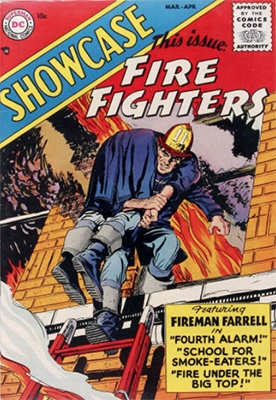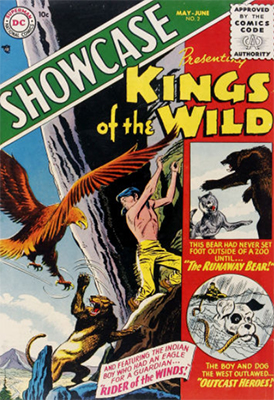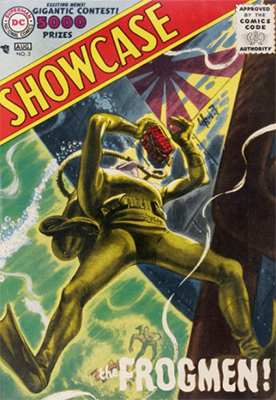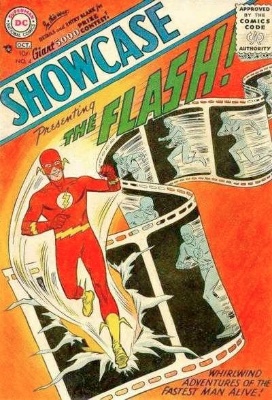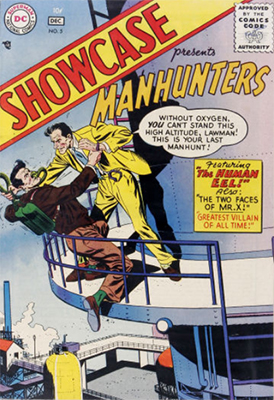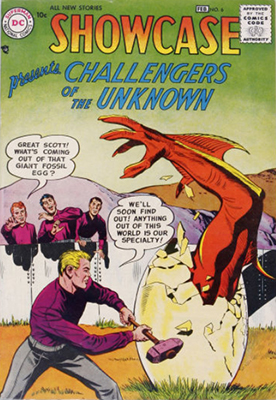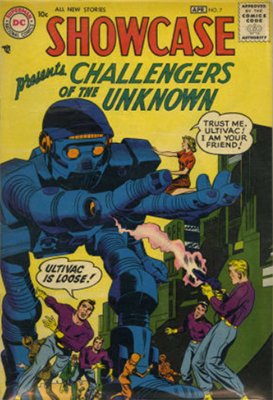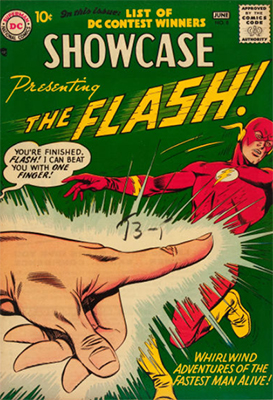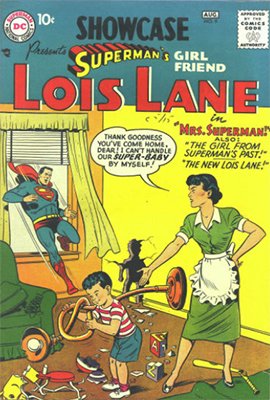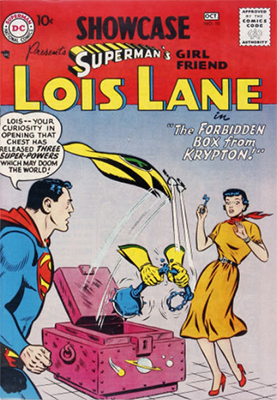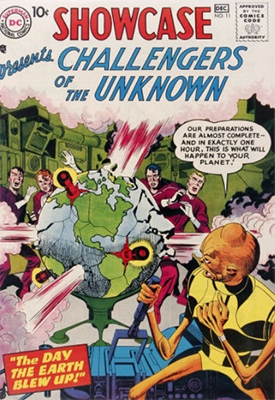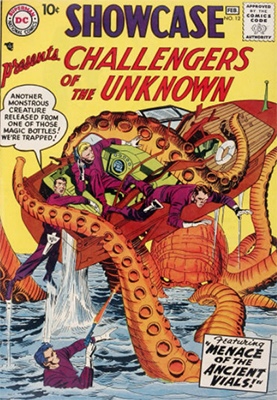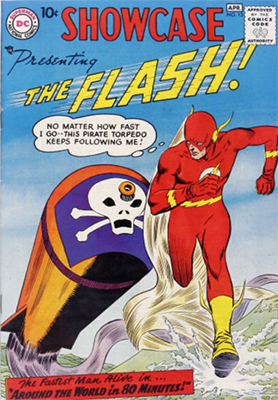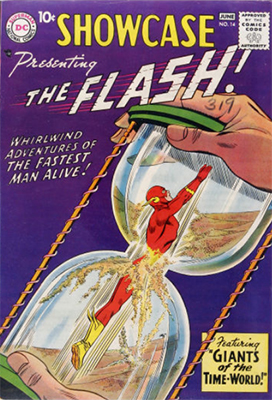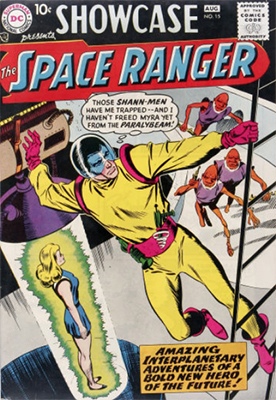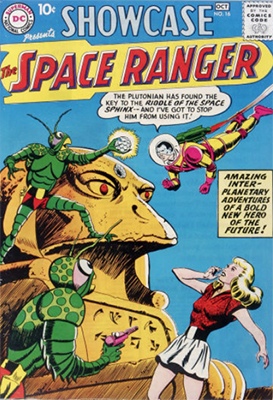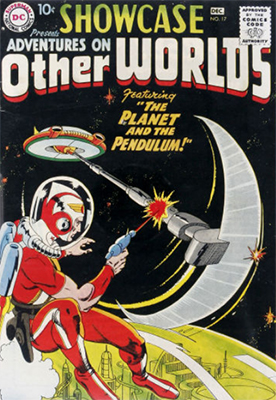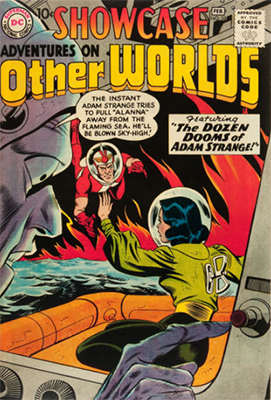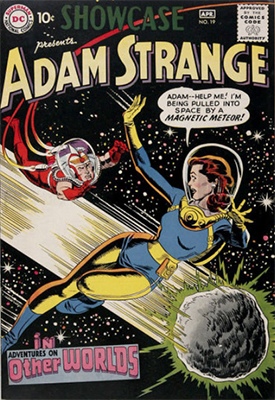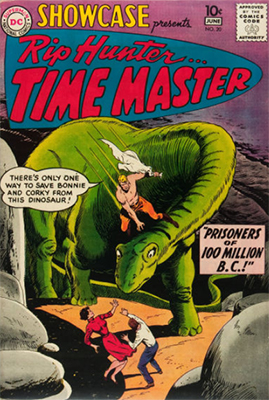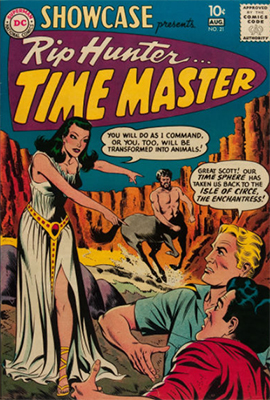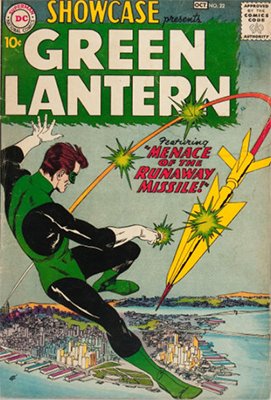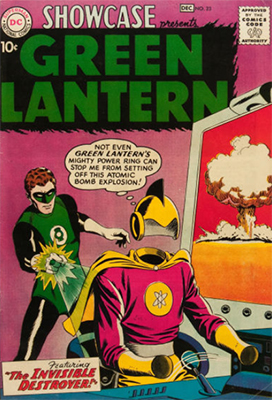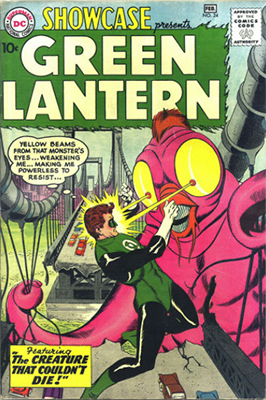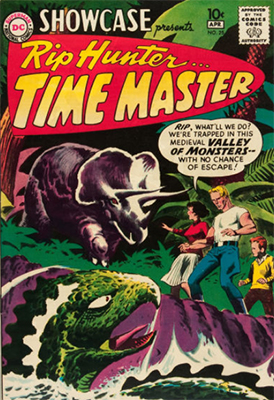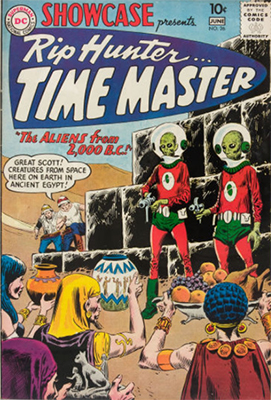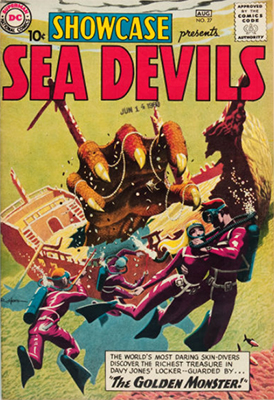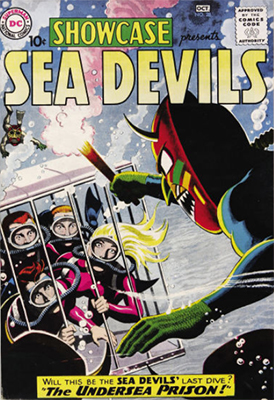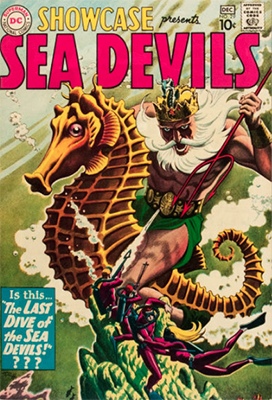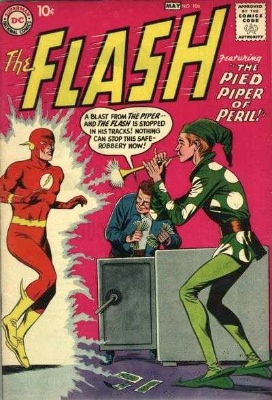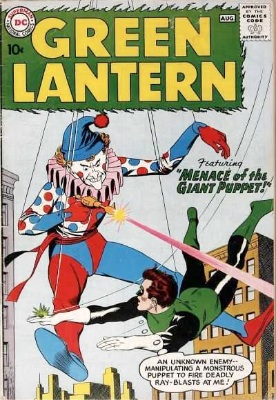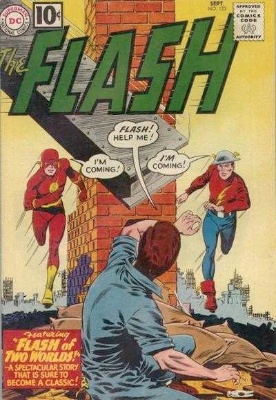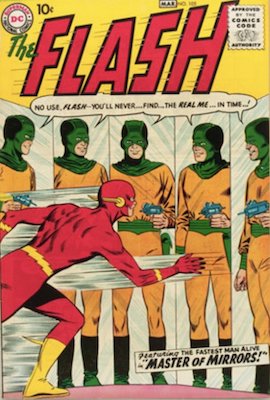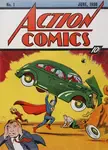DC Showcase Comics Price Guide
DC Showcase Comics Price Guide
Jump to: Part 2 (Issues #30-60) | Part 3 (Issues #61-#104)
DC Comics needed a way to get out of the rut they were in. In 1956, comic books in general were stagnant.
The only superhero comics in production, at any publisher, were DC's Batman, Superman, and Wonder Woman.
Atlas (precursor to Marvel) had no superhero comics at all by '56. All the old Timely-era heroes had fallen by the wayside in favor of more profitable things.
The Comics Code had destroyed EC Comics, and Fawcett had shut down Captain Marvel in 1953, a result of DC's endless lawsuits, and the general trend away from superheroes and towards adventure stories, Westerns, and mysteries.
Something had to give, and when DC editor Julius Schwartz took a chance on reviving an old Golden Age superhero in a new and little-known anthology series called Showcase, give it did.
Everything would be different afterwards. Read more history here.
Have Your Showcase Comics Valued!
If you've got some copies of Showcase, especially #4, #22, or #34, then click here to have them valued FREE by Sell My Comic Books!
Showcase Comics #1 (April 1956): Fireman Farrell?
Record sale: $10,200
Minimum value (poor but complete): $150
This is the first issue of Showcase, the first issue of this legendary tryout anthology comic, the first issue of the comic that brought us the Silver Age Flash and Green Lantern.
Showcase #1 has value, since it is, well, Showcase Comics #1. But the adventures of Fireman Farrell, a non-super-powered, well, fireman, are not themselves the stuff of legend.
As the first issue of an important title, Showcase #1 is quite valuable. It is made more so by the fact that there are very few copies extant, with only 50 unrestored copies graded by CGC.
Showcase #2
Record sale: $2,870
Minimum value: $570
Showcase Comics #4 (1956): First Appearance of Silver Age Flash (Barry Allen)
Record sale: $180,250
Minimum value (poor but complete): $4,000
Showcase #4 is the most important Silver Age comic -- the most sought-after key issue of any comic from any company published between 1956 and 1970.
Jay Garrick, with his quaint-seeming winged Mercury helmet, hadn't been seen since 1951, and five years is a loooong time when your average comic book reader is on the youngish side. Time enough for a complete reboot, which is just what they did.
Without belaboring Barry Allen's story here, suffice it to say that the most important element in Showcase #4 was the beginning of DC's rather neat way of explaining the difference between the two Flashes.
Barry Allen, the new Flash, used to read comics that featured Jay Garrick, the old Flash, when he was a child. Later, we'd find out that the two Flashes were from two parallel earths, dubbed Earth One (oddly, the current, Barry Allen earth) and Earth Two.
The new Flash took off, and the rest is history. This comic is insanely valuable, and there aren't that many around, especially in good shape, although there seem to be more than Showcase #1.
If you have one, you know that it's likely to be worth a small fortune. Mid-grade copies can sell for over $20,000, while in top condition, the sky's the limit.
The Barry Allen Flash also appeared in Showcase Comics #8, #13, and #14 (see below).
Showcase #5
Record sale: $7,800
Minimum value: $100
Showcase Comics #6 (October 1956): First Appearance Challengers of the Unknown
Record sale: $8,660
Minimum value (poor but complete): $100
The Challengers of the Unknown were a Jack Kirby creation. Many see them as a precursor to the Fantastic Four, which Kirby would co-create with Stan Lee just three years later.
There are indeed similarities. Four men, all of whom are non-super-powered but considered heroes just the same, are traveling together on a plane to appear together on a radio show.
Their plane crashes, and the four miraculously survive. Convinced that they are living on borrowed time and that they were somehow spared "for a reason," the four decide to work together, challenging the unknown.
Rather unimaginatively, they then decide to call themselves The Challengers of the Unknown.
The Challengers would go on to appear in Showcase #6, and then again in Showcase #11 and #12, before getting their own title, which would run for 75 issues.
Showcase #7
Record sale: $5,200
Minimum value: $75
Showcase #8
Record sale: $31,200
Minimum value: $230
Showcase Comics #9 (August 1957): Lois Lane's Tryout
Record sale: $12,000
Minimum value (poor but complete): $220
Unlike the so-called Supergirl Tryouts of the Golden Age, in which Lois Lane had more than one opportunity to get some superpowers and use them, this is essentially a romance comic that happens to have Superman in it.
Lois creates crazy situations that almost always, ironically, leave her at odds with Superman or with Clark.
She is eternally caught between her attraction to Superman, and her desire to know his true identity, between her disdain for Clark and her working relationship with him that somehow never makes it obvious enough that he is Superman.
Lois Lane's tryout here was the first feature designed to appeal to female readers to appear in Showcase, but would not be the last. Showcase #9 (and #10) are relatively scarce, but of course are not as valuable as any of the Barry Allen issues are.
Showcase #10
Record sale: $10,760
Minimum value: $80
Showcase #11
Record sale: $9,560
Minimum value: $60
Showcase #12
Record sale: $4,480
Minimum value: $50
Showcase #13
Record sale: $38,400
Minimum value: $160
Showcase #14
Record sale: $13,200
Minimum value: $50
Showcase Comics #15 (February 1958):
First Appearance of Space Ranger (Rick Starr)
Record sale: $16,800
Minimum value (poor but complete): $30
For Showcase #15, DC tried out a science-fiction twist on an old standby: the hard boiled story.
50 percent Western lawman, 50 percent 1930's gumshoe, and 100 percent space opera, Rick Starr, Space Ranger was introduced in Showcase #15.
Space Ranger fought those sort of villains through Showcase Comics #15 and then again in Showcase #16.
Such was the comics audience at the time (1958) that Space Ranger caught on enough for DC to give Rick Starr his own feature (that ran for 40 issues) in Tales of the Unexpected, starting with #40.
It is perhaps surprising to see prices like that for comics featuring a hero that you've never heard of, but such is Showcase's importance, such is the importance of first appearances, and such are the values of collectible early Showcase Comics.
Showcase #16
Record sale: $4,560
Minimum value: $50
Showcase #17
Record sale: $26,400
Minimum value: $75
Showcase #18
Record sale: $1,910
Minimum value: $75
Showcase #19
Record sale: $8,960
Minimum value: $40
Showcase #20
Record sale: $1,720
Minimum value: $60
Check values here
Showcase #21
Record sale: $1,320
Minimum value: $30
Check values here
Showcase Comics #22 (1959): First Appearance of Silver Age Green Lantern (Hal Jordan)
Record sale: $105,000
Minimum value (poor but complete): $380
After the very successful reboot of the Flash in 1956, the powers that be decided to try the same thing with the Golden Age Green Lantern, who hadn't been seen since 1951.
In October of 1959, the new Green Lantern made his debut in Showcase #22.
Arguably, this is the second most important of the Showcase Comics. Since this is the first appearance of the Silver Age Green Lantern, this comic generally sells for a pretty sturdy sum. Finding a copy of this comic, even one in tattered condition, is quite a nice result.
Showcase #23
Record sale: $13,200
Minimum value: $20
Showcase #24
Record sale: $16,800
Minimum value: $30
Showcase #25
Record sale: $3,240
Minimum value: $20
Showcase #26
Record sale: $4,800
Minimum value: $10
Showcase #27
Origin and First Appearance of the
Sea Devils
Record sale: $7,800
Minimum value: $10
Showcase #28
Record sale: $3,600
Minimum value: $30
Showcase #29
Record sale: $1,260
Minimum value: $10
Part Two: Showcase Comics #30 to #60 >>>
We break this article here. Click to see values for Showcase Comics #30 and upwards in part two >>>
More history of the Showcase Comics series follows below.
What Showcase Comics Did For the Future of Comic Book Publishing
It's safe to say that the world of comic books as it exists today has followed a straight line since the dawn of what comic book collectors and fans call The Silver Age.
Most would agree that the Silver Age started in the pages of Showcase #4 in October of 1956, when DC brought forth the new Flash unto comic book readers, and the people rejoiced.
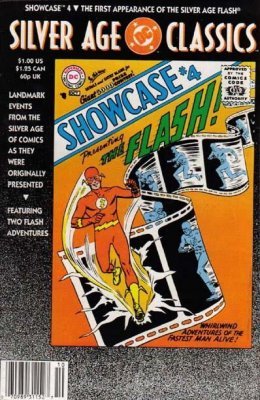
Showcase Comics were what could be called a "tryout" series. In other words, it was designed to be an anthology series that would give new and untested characters an issue or two to gauge the public reaction without the risk of giving them their own series right away.
The other method of doing this, the "spin-off," wherein new characters were introduced as guest stars in established books, worked well enough, but a tryout book was simply easier, and it had the allure of a new concept. And the format then developed its own fans as well.
Besides the Silver Age Flash, over time, the pages of Showcase Comics would introduce (or reboot, or reintroduce, or just provide a high-profile momentary home for) such heroes as Green Lantern, Adam Strange, The Atom, Aquaman and Aqualad, The Metal Men, The Spectre, The Creeper, and Hawk & Dove.
From 1956 until 1970, DC's Showcase Comics was exactly what the name implied: it functioned as a literal showcase for new heroes, heroes of a distinctly different type than the Golden Age heroes they replaced, and who didn't have a regular home of their own.
It was a showcase as well as for some of the great artists and writers of the Silver Age, including legends like John Broome, Otto Binder, Gardner Fox, Gil Kane, Steve Ditko, Jack Kirby, Ross Andru, and many others.
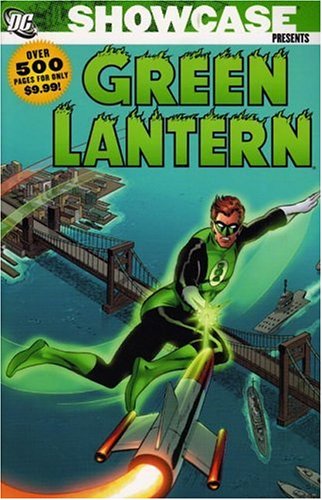
In a way, Showcase Comics ARE the Silver Age. Most people agree that the second great age of comics began with Showcase #4, and while the end of that period is a bit harder to pin down, most place it in the neighborhood of 1970, the year that Showcase gave up the ghost due to lackluster sales amid a glut of DC titles and the utter dominance of Marvel as the Bronze Age began.
There was a brief Showcase revival later, when DC hopefully brought the title back (along with other previously canceled titles and a number of new ones, as part of a desperate mid-'70s marketing ploy called The DC Explosion!) for 11 issues starting in August of 1977.
That run introduced the new Doom Patrol, gave Power Girl her first real solo outing, and even gave the then-terminally-unhip Hawkman a much needed shot in the arm, before Showcase bit the dust once again in what has been called The DC Implosion of 1978, wherein the struggling company laid off a fair chunk of its staff, and canceled 40 percent of its titles.
There is more than enough material and cultural influence to justify a book-length study of Showcase Comics' role in the Silver Age, and the change of direction in comics that has guided the media ever since. Whoever undertakes that task has a great wealth of incredibly fertile characters, writing, and art for inspiration.
But for today, we're going to have to content ourselves with just a bit of a look-see into that world. The sheer scope and quality of Showcase certainly do merit a close examination of some key issues, and that's just what we're going to do.
Click here to read part two of this comic price guide >>>
More of our Comic Price Guides
DC Comics Characters in Showcase Comics
Learn the values of individual hero comics, including all the stars of Showcase, such as The Flash, Green Lantern, Martian Manhunter and many more.
Silver Age Green Lantern Comic Book Price Guide
Learn how much the Silver Age Lantern comics are worth, including Showcase #22, #23 and #24, and his own series.
The Flash DC Comics Price Guide
Learn the values of Silver Age Flash appearances including the Showcase issues, Flash #105, and all the later issues too.
Most Valuable Comic Books of the Silver Age (1960s)
Showcase #4 and #22 are on the list! But what else is in the top 60? Find out here.

